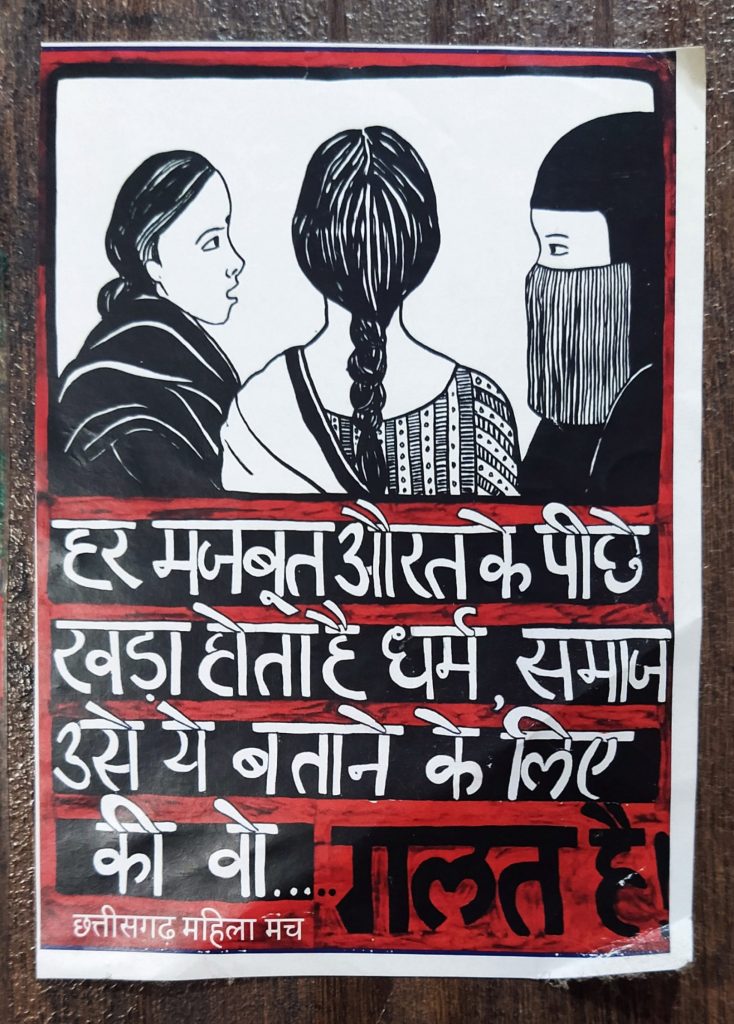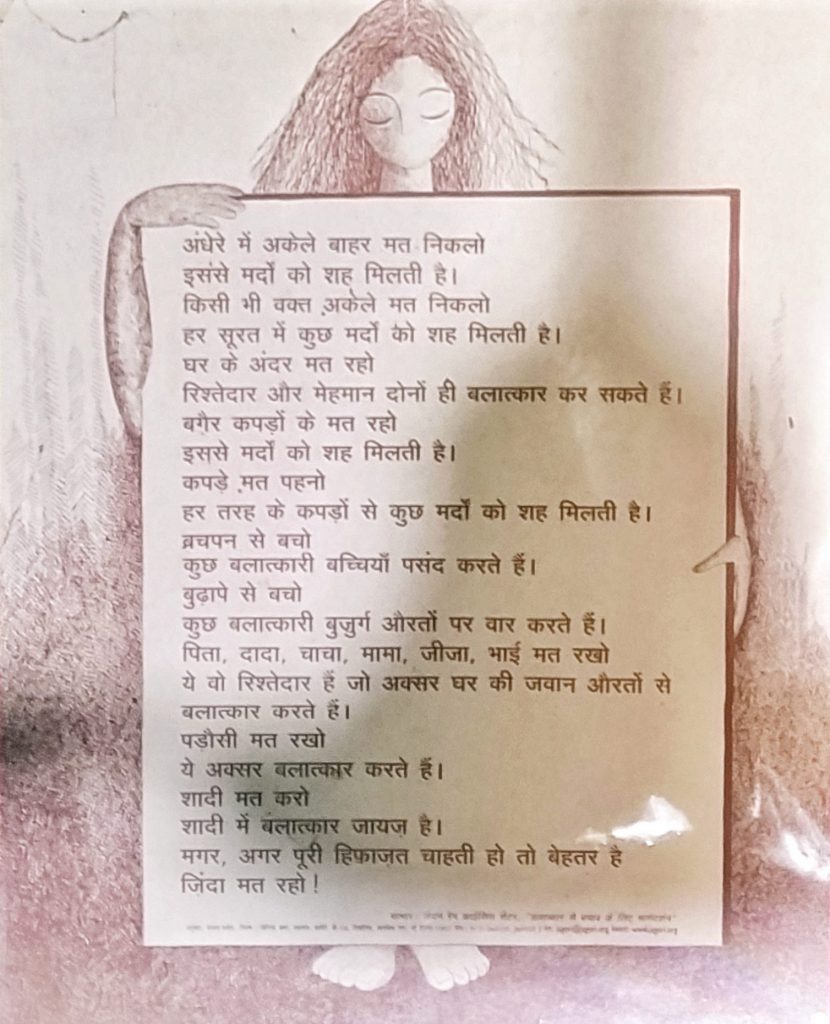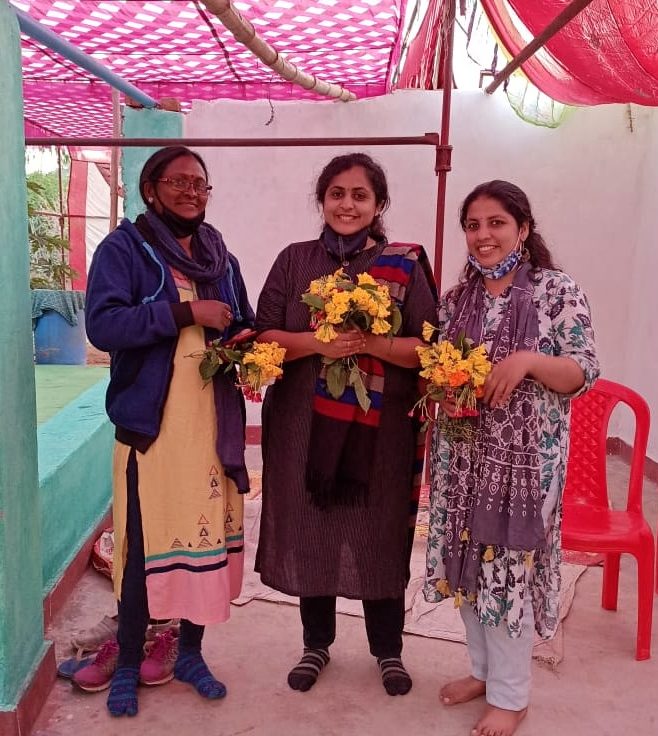Before 2020 could end, we (Nikita D’cruz and I) got to meet a group of 25 local people from the villages of Janjgir-Champa, Chhattisgarh. If you aren’t familiar with the region, it’s one of those towns that aren’t known to many, and have to be referred to, with a nearby bigger, more commonly known city. This one is close to Bilaspur. This group of 25 may have a lot in common but we were introduced to them through Nivedita Foundation (NF), an organization in the region working on gender equity and issues such as violence against women, child marriage, exploitation and sexual assault.
To give you some more background, Paul Hamlyn Foundation (PHF), an international organization that’s financially supporting them (as well as our initiative, Koshika) had told us about the remarkable work being done at Nivedita Foundation, and had connected us with them last year. After multiple conversations on how we could collaborate, a nationwide lockdown in between and a couple of more virtual interactions later, we were at the NF head-office, putting faces to names and getting to know each other. The visuals in the office space instantly make a mark without anyone having to do the talking, and the numerous publications in the form of books and booklets keep one occupied.
All 25 members in this group have been picked by the organization from their respective villages, because of their leadership potential and their willingness to learn from as well as contribute towards social development. From here on, let’s call them PHF leaders, as they’re commonly known. While some of the PHF leaders have joined as recently as six months ago, most of them have been working here for a couple of years now, and some are highly experienced in what they do, having been part of the organization for 8-10 years. Before meeting them in person, we had short telephonic conversations with each one of them, to know their scope of work, learning needs and personal aspirations. This is what we understood:
- All PHF leaders are keen to continue working on social issues in their respective villages, for as long as required.
- They have enough information about the work, such as government schemes and entitlements, processes, procedures, norms and loopholes. However, to some extent, there is a lack of confidence in talking to government officials or higher authority.
- Everyone works hard and doesn’t hesitate from taking required action if they get to know of any injustice or human rights violation in their village.
- There’s enough courage to do the right thing and raise one’s voice. But the ability to articulate and put a point across well has to be worked upon.
- The ability to share knowledge and spread awareness is high, among all the group members. However, the communication skills and the presentation skills could be improved.
- Self-awareness is somewhat a blind spot. It includes elements such as self-identity, patience, and anger management as some of the members shared.
A couple of responses indicated the need to be better at using technology, improving group dynamics, and professionalism at work. Looking at the more common points and limited time of four days to be spent together, we focused on Personal Leadership, Communication, and Presentation skills for now.
Maybe it was the excitement of travelling to Chhattisgarh for the first time, or of physically sitting in a group after 8 months of virtual meetings or the thrill of contextualizing the content for this set of leaders – we were charged, and the group’s energy helped a great deal.
Coincidentally, on the day we reached, a women’s group being facilitated by NF had planned to inaugurate a Haldi (turmeric) grinding machine, an addition to their enterprise where they are already selling nutritious local produce. It was a grand event, and just by the virtue of being guests in the organization, we got invited too. There were women group members, their families specially children, local leaders such as Sarpanch, Sachiv, and the chief guest, Vidhayak, i.e. MLA with his entourage.


Can spot the machine in the background? 
Nikita (in the middle) and I (on the right) with Kaamini ji, a PHF leader
Back from the event, the next four days were largely to be spent in the training room. Here are some of the highlights out of numerous interactions and learning from each other:
1. Looking Back – Understanding Lives And Context
It’s not everyday, or even every year that we take out time to think of our life journey, or what we remember of it, leave alone telling it to someone else. On the first day, as the group was opening up, not just to us but also within, everyone reflected on the milestones in their lives – good, bad and ugly. We individually made an attempt to show it visually, by drawing it on a chart paper, and then displaying all of it as art work as if the room was an art gallery.
Everyone participated with interest and enthusiasm. For many, this was the first time in years that they had been asked to draw about their life. It helped us a great deal in understanding the leaders, where they come from, and how they perceive their own journey until now. This also facilitated deeper interactions among the leaders, as some of them did not know about each others lives. Images of families, weddings, communities and schools, came up the most. There were commonalities and differences in the way they shared, yet everyone came out with a learning.
2. Telling One’s Story
Next, we sat in pairs, thought of one episode or instance from the entire life journey, as drawn, and narrated it to the partner in the given time, i.e two minutes. This needed preparation and practice before the actual narration. The idea was to work on comprehension, articulation as well as deep listening. We gave a demonstration, i.e. I told Nikita, my co-facilitator’s story to everyone and she told mine, to emphasize on listening carefully and not losing the essence of the story in re-telling it. All the leaders then repeated the same.
What almost everyone struggled with, was to choose one incident, and consequently, sticking to the time limit. Most of the leaders started from the beginning, narrating the entire life journey largely in this format – life before joining PHF, how they became a team member and the work they do now. Those who did well at storytelling and time management were also the ones who could pick just one incident, and not a series of events.
At the end of the day, they decided to practice summarising and narrating one event, with each other. A couple of examples for effective storytelling were also shared, such as this one by Meena Soni.
3. Identifying Stakeholders We Work With
Moving from self to the immediate circle of people we regularly interact with, as PHF leaders, we facilitated a discussion on stakeholders. The 25 leaders worked in smaller groups and came up with a laundry list of all possible people, departments and institutions. To arrive at a common agreement and understanding, each point was looked at, and was either accepted or rejected by the group. This is how the entire list looked like:

Now, to understand the frequency of interactions and comfort with each stakeholder, the group divided them into four categories:
- Daily/weekly interaction and easy to interact with
- Daily/weekly interaction but difficult to interact with
- Monthly or less frequent interaction and easy to interact with
- Monthly or less frequent interaction and difficult to interact with
Primarily, this gave all of us an idea as to where the group is, in terms of working with different stakeholders. Secondly, and more importantly, it led us to explore possibilities of peer-learning. For example, Mahesh could help Gurbari with the experience of working with BDO (Block Development Officer). She could also accompany him the next time he goes to meet the officer.
This was followed by the PHF leaders demonstrating interactions with government officials and other stakeholders, through role-plays. Jayant remarked how, in the real scenario as well, one could think of it as acting, and give a performance, be it to the District Magistrate (DM) or to the youth group in one’s village.
4. Having Meaningful Conversations At Work
While working with stakeholders, it’s not always presenting your viewpoint or giving a monologue. In fact, more often than not, it is about having one-on-one conversations, trying to understand the other person’s viewpoint. Many of these PHF leaders counsel women and girls on issues of domestic violence and child marriage. They also work on getting employment opportunities, enabling access to government benefits and socially empowering people in their villages, all of which needs them to talk to these people.
To do it more effectively and efficiently, we introduced ‘Semi-Structured Interview’, a tool to have in-depth conversations with people, in an interview format where some of the questions are pre-designed while the others are added while talking. Here’s an audio note we used to explain this tool and its usage, recorded by our team member Saurav Verma.
This was done not only to understand the concept theoretically but to also apply it in the everyday work.
5. Visiting A Village To Come Back With Stories
The next day, all the PHF leaders, in groups of 4, were to go to a village each and using semi-structured interviews, had to build their understanding on a given topic such as Aspirations of youth living in the village, Pregnancy care followed by mothers, Role of IT and media on people’s lives etc. The idea was to give them relatively unfamiliar topics to build their collective understanding on it as well as to work in teams and gain insights.

Ideally, the leaders would use all that that was discussed and practiced until now – deep listening, comprehension and articulation, talking to multiple stakeholders, and designing a semi-structured interview. They would then come back and share their experience with the rest of the group.
6. Making An Empathy Map
It was not new for this group to have gone to a village, since they live and work there. What was important was to focus on the tools and techniques to be able to come up with insights, and not just leave with any information. For that, we used the layout of an empathy map.

Each group looked at all the four components, and filled it for their topic in the village they visited. Here’s an example from a group that observed the ways of pregnancy care followed by mothers.
- Do – Aanganwadi worker was sitting in the Aanganwadi centre
- Say – “Deliveries also happen at home”
- Think – ASHA worker is aware and has enough information
- Feel – Nervous, wondering who are these people asking questions
Once done, they tried to infer insights from it, as per their understanding on today’s experience. It was challenging to not think of related past experience or to ignore the knowledge they already had.
7. Presenting The Insights
The last day was majorly spent on making group presentations given this format – beginning with information about the village they had gone through, the people they spoke to, insights generated on the given topic, and one detailed story of a respondents, supported by pictures and/or a small video. The audience was to give feedback on content, flow, body language, time management and participation. Before getting on to it, we talked about the Dos and Don’ts of giving and receiving feedback.
We also recorded all the presentations to play it back to them, so that they can observe themselves and learn from it to make improvements. Here’s a small clip:
Most of the PHF leaders were making a formal presentation for the first time, and were nervous about it. Considering that, the full participation and effort by everyone was commendable. While some of them introduced themselves and their topic, some completely skipped it. The detailed story section, as shown in the video, was the strongest for all. The insights needed more work.
Time management could have been better for all the groups. A round of rehearsal may have been useful. Chart paper, as a tool to present, was optional, and while none of the groups took that option, it would’ve helped to remember certain points and cues. Eye contact, and body language, in general has to be practiced by making more such presentations internally with each other and outside.
8. Making An Elevator Pitch
To be able to use the presentation skills well, combined with gaining the confidence of talking to an authority, we arrived at the skill of making an elevator pitch – to put across one’s point in a short time. Each one of the leaders had to pick a social issue they wanted to raise in front of the District Magistrate (DM), and rehearse the pitch to be given in one minute. This was to be done individually by the PHF leaders. They could of course, practice it with their peers.
Nikita played the role of a DM, and the sub-group of 5 most experienced leaders gave feedback using the Dos and Don’ts discussed previously. More than half of the group members did tremendously well, applying all that we talked about until now. The rest were either just nervous or needed serious preparation. They took the feedback and practiced some more.
9. Reflecting And Wrapping-up
As we came closer to the end of this module in capacity building of PHF leaders, among other things, we wanted them to think and make a note of actions they would take to develop themselves as better leaders. This could be on the basis of formal and informal feedback received or any other self-realization. Some of the common points that came up are:
- Making eye contact while talking
- Listening attentively
- Doing self-work and preparing well
- Finding opportunities to face higher authority more frequently
- Modifying content on the basis of the audience
Before we meet again after a gap of three months, they would be working on these steps, to be able to develop themselves personally and professionally. They also left feedback for us, some common points from which are as follows:
- The applicability of the module in everyday work is high
- The facilitators simplified all the concepts, making it easy to understand
- It was a friendly environment that enhanced learning. However, the facilitators could have been a bit more strict and serious
- We got relevant information in the last 4-5 days
- Nivedita Foundation should organize more such training sessions
10. Moving Forward
Based on these four days, and the suggestions of the founders of Nivedita Foundation, we plan to conduct the next part of this training in March 2021, focusing on three aspects – Documentation using Text/Audio/Video, Visioning for one’s village and Vision for self. The detailed plan is to be discussed and a common understanding between all stakeholders to emerge, so that the PHF leaders make the most out of it.

All in all, the experience with this group of 25 leaders was exceptional and gave all of us food for thought and steps to act upon. It was heartening to see all the efforts they put in, during the sessions and in their ever-challenging work. We are grateful to PHF, for giving us this opportunity that’s mutually beneficial, as much to us as to the leaders who gave their time and attention in the middle of other life and work commitments.







0 Comments